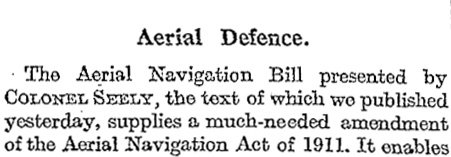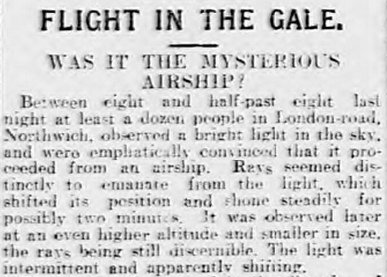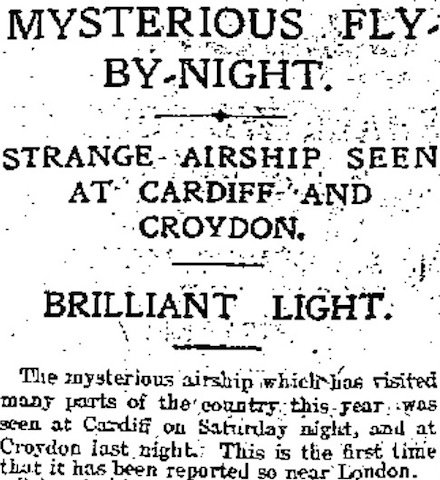
The Times hasn't been ignoring the phantom airships, but neither has it focused its editorial attention on them -- until now. The third leading article in today's issue is in support of the government's new Aerial Navigation Bill, arguing that 'This strengthening of existing legislative powers can hardly be thought premature, and may indeed be regarded as somewhat belated' (p. 7; above). The Times thinks the mystery airships are real, and it also thinks they are hostile.
It must have occurred to many people that the visits of foreign airships are becoming unpleasantly frequent, especially in view of the fact that we have no means of returning the compliment. They have a way of appearing over our ports just after nightfall or before dawn, coming no one knows whence and going no one knows whither. It would seem that either they have a predilection in favour of following our coastline, or they pass unnoticed, possibly at a greater height, across our territory. During the last four or five months they have been seen over Sheerness, Portsmouth, Dover, Liverpool, and on two separate occasions over Cardiff. Their course has never been traced. They are sighted at a given spot and then they disappear. That circumstance not only gives a surreptitious air to their visits, but raises an unpleasant suspicion that these visits may be more frequent than we know.
It then goes on to explain the threat posed by these mystery airships:
This aerial espionage of unknown extent and minuteness is an intrusion which we have a right to resent. Its motives are not likely to be friendly, nor can we flatter ourselves that the beauty of a bird's-eye view of our ports is so great as to lead foreigners to spend so much money in order to derive æsthetic gratification from it. Airships are already capable of being used to do a great deal of mischief, and their powers in this respect will certainly be extended. Suppose, for the sake of argument, that the possibility of using such powers has entered into the calculations of some foreign country, it is obvious that this reconnoitring in time of peace might be found of great utility should an occasion arise.
The Times rejects the notion that there exists a freedom of the air as there does a freedom of the seas: 'The analogy of the sea is no analogy at all. A ship on the high seas cannot drop explosives into our arsenals, but an aircraft can'. Moreover, even on the high seas every ship 'has to display her name and to carry papers showing her movements, her registry, her nationality, and so forth. There is no analogy between ships and these aerial visitors to our ports'.
Our sovereignty goes up to the sky and down to the centre. In the past it has not been necessary to say so because no one had the means to challenge our dominion or to invade our atmosphere without first conquering our soil. The means of attacking us through and by the air now exist. It is therefore our business to define our rights and to make it plain that the air above us is our own, subject, like our soil and our territorial waters, to whatever municipal regulations we find it expedient to make.
And not only is legislation along the lines of the Aerial Navigation Bill necessary, but 'we also need an aerial police to enforce our regulations, in addition to whatever means we already possess'.
...continue reading







